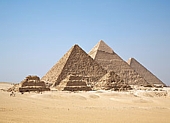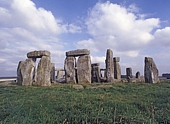Special case: Archaeoastronomy (as a related discipline)
This discipline studies all those archaeological remains that have had some relationship with astronomy, by the cultures that used them. This gives an idea of the astronomical knowledge that some ancient cultures possessed, and how they dedicated themselves to studying the heavens through various types of constructions.
Archaeoastronomy is spread throughout various places in the world, but some of the most important refer to those found in China, Egypt, England, North and Central America. The main uses that these constructions had was to serve as a guide to mark certain astronomical events, such as solstices and equinoxes, as well as orientation in time using clocks and solar calendars, or to serve as an observatory for the observation and study of celestial bodies.
Egyptian pyramids
 One of the best preserved archaeological remains today, whose first prototypes date back to around 2,500 BC, and served as tombs of the pharaohs who reigned in ancient Egyptian culture. The Egyptians were also good astronomers, and proof of this is found both in the numerous hieroglyphs that contain astronomical data, as well as the way they built some of their pyramids, which have several intentional alignments to demarcate astronomical phenomena. The pyramid of Gizeh is aligned with the North Star, and its shadow allows them to determine each of the seasons of the year. The Great Pyramid was used as an astronomical observatory.
One of the best preserved archaeological remains today, whose first prototypes date back to around 2,500 BC, and served as tombs of the pharaohs who reigned in ancient Egyptian culture. The Egyptians were also good astronomers, and proof of this is found both in the numerous hieroglyphs that contain astronomical data, as well as the way they built some of their pyramids, which have several intentional alignments to demarcate astronomical phenomena. The pyramid of Gizeh is aligned with the North Star, and its shadow allows them to determine each of the seasons of the year. The Great Pyramid was used as an astronomical observatory.
stonehenge
 Neolithic monument, specifically from the Bronze Age. It is located in Wiltshire, England, and is made up of gigantic stone blocks that are distributed in a circular shape, in four concentric circles. It is thought that it was a place where various ceremonies were held that are not completely understood, but clearly had some astronomical purpose. Stonehenge is a gigantic observatory and solar calendar, which allows predicting the seasons of the year, because it serves as a guide for solstices and equinoxes. The construction of these megaliths dates back to around 2,500 BC, while a sand circle surrounding the monuments is older, dating back to 3,100 BC.
Neolithic monument, specifically from the Bronze Age. It is located in Wiltshire, England, and is made up of gigantic stone blocks that are distributed in a circular shape, in four concentric circles. It is thought that it was a place where various ceremonies were held that are not completely understood, but clearly had some astronomical purpose. Stonehenge is a gigantic observatory and solar calendar, which allows predicting the seasons of the year, because it serves as a guide for solstices and equinoxes. The construction of these megaliths dates back to around 2,500 BC, while a sand circle surrounding the monuments is older, dating back to 3,100 BC.

